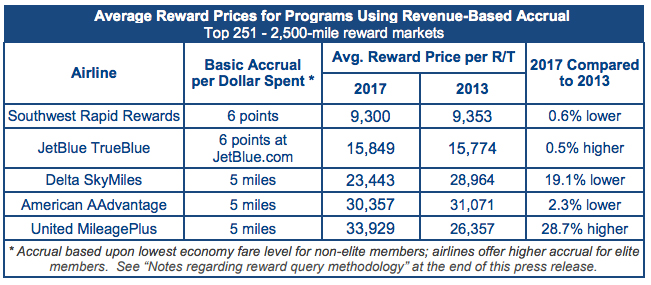Modal title
One fine body…
September 06, 2017
Southwest, JetBlue Lead Average Reward Price Rankings Among Five Major US Frequent Flyer Programs
|
2017 CarTrawler Reward Seat Availability Survey also finds that Delta SkyMiles reward prices
Low-cost carriers Southwest and JetBlue continue to offer US flyers the lowest average reward seat pricing, despite an industry shift to dollar-based rather than mileage-based loyalty points accrual. The annual rankings for the two airlines remain unchanged since 2013 when average reward seat pricing was first calculated.are 19% lower than in 2013. These findings derive from the IdeaWorksCompany annual CarTrawler Reward Seat Availability Survey. In May the firm released reward seat availability rankings for 25 of the worldÕs largest airlines. Today's analysis features average reward prices associated with US frequent flyer programs that use ticket prices, rather than miles flown, as an accrual method. Among these programs, the pay-with-points method used by Southwest and JetBlue yielded lower prices for short and medium haul reward travel. American, Delta, and United, along with JetBlue and Southwest, now base accrual on the fares paid by frequent flyer members. Among low fare economy passengers, who donÕt have elite tier status, JetBlue's TrueBlue and Southwest's Rapid Rewards programs offer higher accrual at 6 points per dollar compared to the rate of 5 miles per dollar offered by the others. The generosity of JetBlue and Southwest is surprisingly combined with lower average reward prices, Southwest being the lowest in the survey results at 9,300 points per roundtrip reward.  ItÕs obvious Delta made a genuine effort to reduce reward prices on its mainland US routes as reflected by the nearly 20% reduction since 2013. Frequent flyers are far less pleased by the 28.7% increase for average reward prices observed for United MileagePlus. Back in 2013, 83% of UnitedÕs mainland US query results were priced at 25,000 miles or lower; for 2017 this statistic dropped to 43%. Among the five airlines, the similarity of the accrual methods permits the comparison of average reward prices. In addition, the accrual rates for their basic co-branded credit cards are universally the same at one point or mile per dollar charged for everyday purchases (more miles may accrue for special purchases or with high fee cards). These features have created a situation in which points and miles have become equivalent currencies for these five airlines. In reality, the currency used by American, Delta, and United is now more accurately defined as ÒpointsÓ because it is no longer associated with distance. Data was also collected for Alaska Airlines and Air Canada. The results were not comparable because these airlines continue to base accrual upon miles flown. However, their co-branded credit cards, which generate a significant quantity of miles for members, generally offer the same accrual of one mile per dollar charged, suggesting some approximate likeness among all seven programs. The average reward price was 18,500 miles for Alaska's Mileage Plan and 23,054 miles for Air CanadaÕs Aeroplan program; which would place them third and fourth, respectively, in the rankings. Alaska made a significant effort to lower its average reward price, which saw a drop of 24.8% since 2013. The pay-with-points method (JetBlue and Southwest) links reward prices to prevailing air fares. Program members can seek out low reward prices on flights that have lower fares. Reward prices adjust to demand in the same way fares have since supersaver rates were introduced decades ago. The mileage-based method is far less precise and typically ranges from 25,000 to 50,000 miles for a roundtrip domestic US reward. American, Delta, and United add pricing flexibility such as lower-priced rewards for flights under 500 or 700 miles, or select flight discounts. The big 3 major airlines are embracing more graduated pricing methods which removes the predictability of the traditional 25,000-mile and 50,000-mile classic reward option. American, Delta, and United have changed their programs to more generously reward members having elite status such as silver or gold. These members may enjoy more than double the usual points accrual, which greatly affects the ability to compare average reward prices among the five airlines. Ultra-frequent travelers may realize better reward value from these airlines. But for everyday consumers buying the lowest fares, the pay-with-points method embraced by JetBlue and Southwest, along with the classic mileage-based method used by Alaska, delivers better reward deals for economy class travel in the US. Copyright 2017 IdeaWorksCompany. All rights reserved. From http://www.ideaworkscompany.com.
|
To view all articles, check out the Internet Travel Monitor Archive